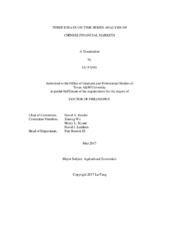| dc.description.abstract | This dissertation studies three important issues in Chinese financial markets. The interdependence structure and information transmission among Chinese cross-listed stocks in Shanghai, Hong Kong and New York is examined. Results indicate that the home bias hypothesis, which suggests the dominant role of home market in pricing information transmission, is strongly supported in contemporaneous time, modestly supported at the short horizon and not supported at the long horizon. The Shanghai market as the home market is highly exogenous at all horizons. Moreover, the Hong Kong market leads the New York market in contemporaneous time.
Whether interest rates help to forecast stock returns in China is studied using the prequential approach. With respect to calibration (reliability), it is found that including interest rates in the model improves the model’s ability to issue realistic probability forecasts of stock returns – a model of stock returns that does not include interest rates as an explanatory variable is not as well calibrated as a model that does include interest rates in the stock returns equation. With regard to sorting (resolution), results suggest that the model that includes interest rates performs better in distinguishing stock returns that actually occur and stock returns that do not occur when compared to a model that does not include interest rates in the stock returns equation. Overall, the interest rates help in forecasting stock returns in China in terms of both calibration and sorting.
Two factor analysis methods are investigated through forecasting Chinese interest rate based on a factor-augmented vector autoregression (FAVAR). Factors are estimated from 288 Chinese security series to reflect the common forces that drive the movements and dynamics in the Chinese equity market. As a result, the factor estimation method by Lam and Yao outperforms the traditional principal components analysis (PCA) in terms of forecasting accuracy, especially at the short horizons. | en |


